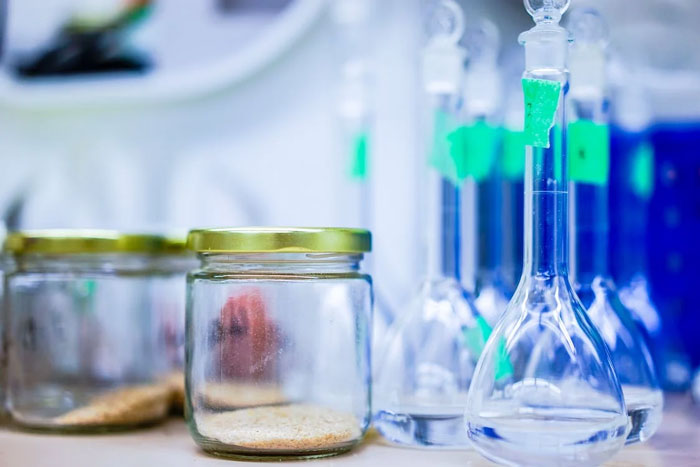
This post covers in detail the hazards associated with barium chloride; the safety precautions to take, and the first aid measures to apply whenever an accident occurs.
Please, continue reading to learn about barium chloride and how to handle it effectively.
What is Barium Chloride?
Barium chloride, with formula BaCl2 and IUPAC name barium dichloride, is one of those compounds that do not have carbon, thereby making it an inorganic compound.
It is a white odorless and colored chemical substance that is highly soluble in water. Most laboratories and industries don’t use it frequently because of its toxicity. It is quite different from other barium salts.
This article will serve as a guide for you to use this chemical safely without causing yourself harm.
Common Barium Chloride Hazards
Barium chloride is a harmful chemical that should be handled with extreme caution. It dissolves in water quickly; water that contains barium chloride should not be consumed or bathed with.
It affects the respiratory system by causing difficulties in breathing. It also causes weakness in the body; it harms the nervous system and can damage the heart.
It is a chemical that should never be inhaled, swallowed, or allowed to touch the skin or eyes.
Barium Chloride Safety Handling Procedures
Barium chloride should be handled with care due to its toxicity. Do not handle barium chloride while eating or drinking, there may be a possibility of you ingesting it.
Avoid smoking while working with or near barium chloride. Put on a protective kit that can keep the eyes and respiratory tract away from this chemical.
Barium Chloride Safety Storage Procedures
Store barium chloride in a well-sealed container and keep it in a dry and ventilated place. Examine the area where this chemical is stored and make sure there is no trace of heat or fire around it.
Barium Chloride Safety Disposal Procedures
You can wash barium chloride down the drain because of its solubility in water. But make sure you dilute it with lots of water before flushing it away to minimize its toxicity.
Do not dispose of barium chloride in rivers or streams because of the danger it poses to aquatic lives. It is harmful to the fishes and other creatures in the water.
How to Handle Exposures to Barium Chloride
Barium chloride is not a friendly substance on the skin or in the stomach. When using this chemical, accidents may occur. But if that happens, what should you do?
You have to act fast and use a safety precaution method to minimize or prevent the harm that barium chloride could cause.
Follow these first aid measures whenever you encounter accidents handling the chemical:
- When inhaled: Transfer victim to a ventilated place that has enough fresh air, then call for medical help immediately, else the respiratory tract may be damaged.
- When ingested: Inducing vomit is a bad decision, except you are directed by a physician to do so. Rush victim to a medical facility, otherwise the intestinal areas can be damaged.
- If it touches the skin: Wash your skin with enough water for about 15-20 minutes. Take off your clothes if they have the chemical on them.
- If it touches the eye: Wash eyes with enough water for about 15 to 20 minutes while it’s opened. Remove contact lens if you have any. If you still feel uncomfortable, get medical help immediately. Remember this chemical is very harmful, it can damage the eyes.
Barium Chloride Properties (Physical and Chemical)
Barium chloride is well known to have a boiling point of 1560 degree Celsius while its melting point is 962 degree Celsius.
It has molar mass of 208.23 g/mol and a density at 3.856 g/cm3.
Barium chloride is white crystalline solid with no odor. It is also hygroscopic because it absorbs moisture from air.
It is well soluble in water but practically insoluble in acids, acetone, and ethyl acetate, and ethanol.
When heated until it decomposes, barium chloride produces chlorine fumes, which is toxic.
Barium chloride solution is neither acidic nor basic, but neutral. Its pH value is 7.
The explanation for barium chloride solution being neutral is thus:
When dissolved in solution, barium chloride produces the barium cation, Ba2+ and the chlorine anion, Cl-.
Since both cation and anion are from the strong base, barium hydroxide, Ba(OH)2 and the strong acid, hydrochloric acid, HCl, they will therefore not react with water molecules (i.e. hydrolysis will not occur).
Since hydrolysis does not occur in barium chloride solution, it means there is no additional production of either H+ or OH- ions in the solution, which could have made the solution acid or basic.
Therefore, barium chloride solution is neutral!
Barium Chloride Preparation
You can make barium chloride by diluting hydrochloricacid with water, and then place it in an evaporating dish (made of ceramic).
Barium Chloride Uses
Barium chloride is primarily used in industries for purifying salty water (popularly known as brine solution).
It is also used to produce salts applied in heat treatment of metal surfaces; for pigment production, and also in the production of its parallel barium salt. It is also used as a rat poison.
Barium chloride can also be used as a reagent for performing analysis, and as a dehydrating agent.
Conclusion
Barium chloride is a toxic chemical that can be very harmful to the body (externally and internally).
It is not widely used in laboratories and industries like other chemicals. This chemical should be handled with extreme caution in order to avoid hazards.
Read and follow the safety procedures given in this article to work with barium chloride properly.
